Scaling a startup is hard. Scaling a startup bank is even harder. Scaling a consumer-focused financial platform—that is also now the primary bank account for millions of UK consumers—in the midst of a once in a century pandemic is close to impossible.
In April 2020, British banking startup Monzo’s revenue fell by almost 50%. But the company will end 2021 with revenues close to 2x its pre-pandemic peak, in spite of continued low interest rates, reduced travel, and depressed pandemic spending.
This did not happen by magic. Monzo’s culture of customer obsession allowed it to use the crisis to thoughtfully build a beloved consumer and SMB product that has changed personal finance in the UK. In 2022 and beyond, Monzo’s revenues are likely to further accelerate as they benefit from cross border-travel, increased EU interchange rates, and new products.
Banking is a ubiquitous but hard to crack industry. In the United Kingdom alone, there are 73 million personal accounts and four million business accounts, through which customers make more than 40 billion payments per year and hold £1.5 trillion in deposits. Over 96% of UK adults already have a bank account. When Monzo launched in 2015, the big six banks in the UK had more than 85% market share.1
But ubiquity and lack of switching doesn’t necessarily mean customer happiness. In fact, the net promoter score (NPS, a measurement of customer loyalty) of banking in the UK is a very low 18.2 Incumbent banks miss the mark in two crucial areas:
- The banking experience has not evolved to match modern consumer
expectations. Banks still rely on physical branches and don’t give
users the ease of use, feedback, and visibility consumers have come
to expect. - Bank business models are not aligned with customer interests.
Banks do not incentivize better money habits. Their profit models
rely on upselling and non-transparent fees that typically penalize
the most vulnerable customers. The average personal account in the
UK has £150 to £220 in fees per year, many of which are hidden.
In 2015, Monzo founders Tom Blomfield, Jonas Templestein, Gary Dolman, Jason Bates, and Paul Rippon launched a digital finance platform with the slogan “Make Money Work For Everyone.” The first iteration of the Monzo account was a simple prepaid card that allowed UK customers to open an account online and for free, receive real-time spending notifications, and budget their finances.
Today, Monzo is a full-fledged financial platform that offers customers:
- A best-in-class spending account with a modern user experience, real-time payment notifications, and low fees
- Money management features such as spend trends, transaction categorization, and monthly spend summaries
- Social features to pay your friends (e.g., Venmo) or split the bill (e.g., Splitwise)
- Virtual account creation and controls (e.g., pay bills from a specific virtual account)
- Access to capital through overdrafts and Monzo credit products
- Access to savings accounts through marketplace partners
- Premium accounts with additional software tooling and perks
In just five years, Monzo has reached impressive density and scale in the UK with minimal marketing spend. Monzo now has over five million customers, 55% of whom are active weekly. Of those that are active, over 40% are using Monzo as their main account with this number steadily increasing in each customer cohort. TS Anil (CEO) and Sujata Bhatia (COO) joined Monzo in 2020 to further improve operational excellence in risk management, lending, regulatory and compliance. When they joined, Monzo was generating $69M in revenues (in April 2020). In the 18 months since the pandemic began, revenues have scaled to more than $200M and deposits have grown to $4B+.
In this post, we will walk through what drove Monzo’s early success, how it has come to dominate the UK market, and the company’s opportunity to change the landscape of global financial services with its beloved brand.
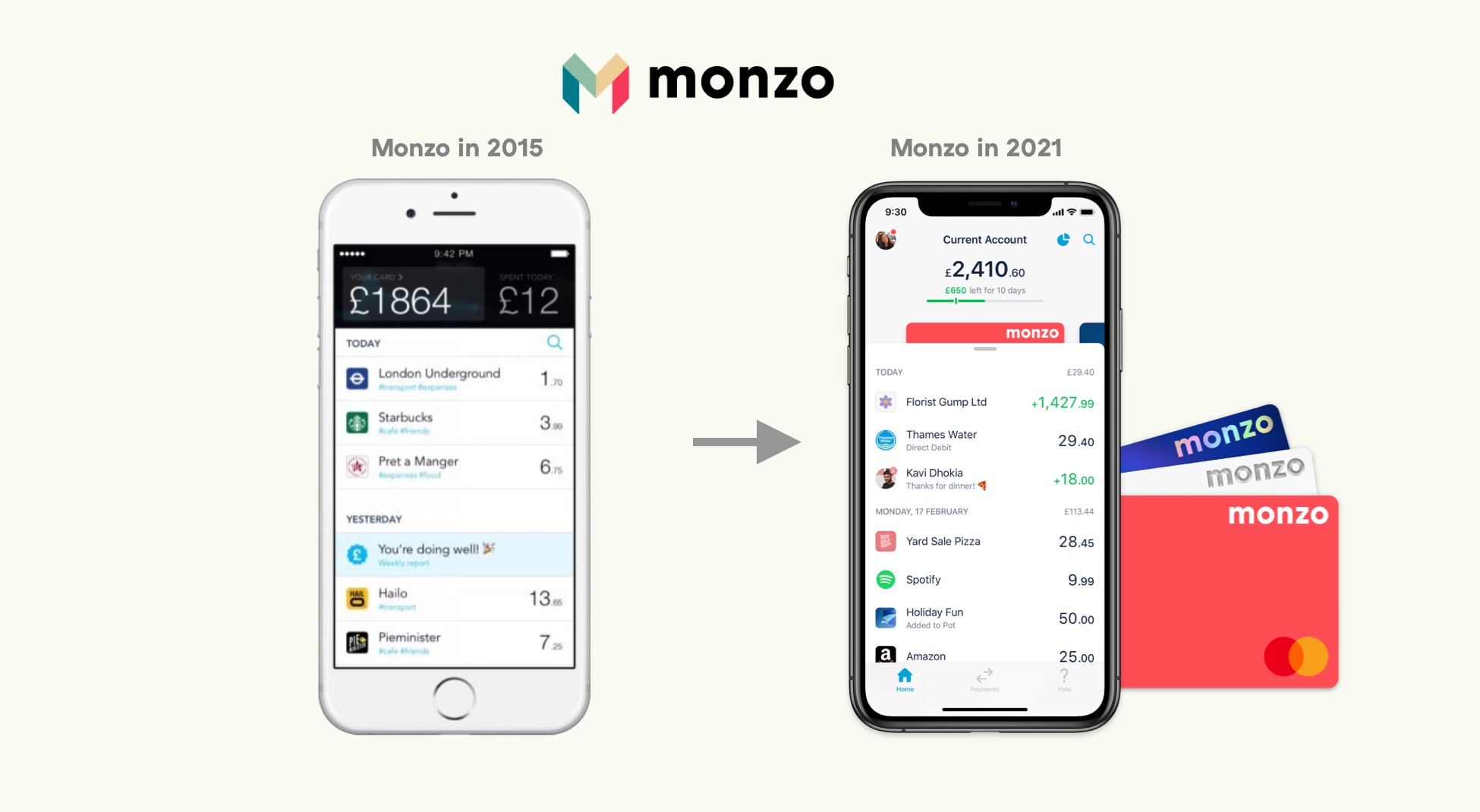
Early success: Foundations built on product and community
Outperforming incumbents with modern experience and digital infrastructure
Monzo believed that it could solve a major concern that incumbents couldn’t: Traditional banking infrastructure does not support the convenience and modern experience that customers have come to expect in the digital age.
Monzo attacked incumbent models by creating an entirely app-based experience where customers could open a checking account from their phone for free. Monzo had the insight that customers should be able to do everything from the app. This includes storing money, sending and receiving payments, paying friends, budgeting their finances, and accessing capital via overdrafts and buy-now-pay-later (BNPL). With a Monzo account, customers do not need peer-to-peer payments apps like Cash App or Venmo, spend management tools like Mint, or BNPL services like Affirm or Klarna. Monzo provides all these services in a single easy-to-use interface. Eventually, this will extend into wealth generation tools to help customers grow their finances. Monzo’s vision is to become an all-in-one app where customers can do everything they need to from a single place.
Monzo also cracked world-class customer support via in-app chat. Customers can send messages and receive a response quickly, regardless of the time or day. While a seemingly obvious insight, this has been an enduring differentiator. Traditional banks can’t do this because (1) their service models are tied to individual branches and (2) they rely on legacy monolith and mainframe tech infrastructure that makes daily/weekly product deployment cycles impossible. At launch, Monzo was able to offer features not offered by competitors, like real-time notifications on spending, simple personal-finance management software, and the option to freeze your card. This immediately made it a 10x better product and service.
Monzo has also been able to move faster than incumbents because of its forward-looking approach to building banking infrastructure. Instead of a massive code base with limited deployment flexibility, Monzo built with scale in mind and used a microservices-driven architecture. Microservices breaks up an application’s code base into independent services that talk to one another through APIs. This allows engineering teams to deploy code more frequently because deployment only impacts the microservice they are working on. In comparison, most incumbents were pushing updates on a quarterly or annual basis. This simple decision enabled Monzo to quickly launch spend categories, round up transactions, pots (sub accounts), trends (where you can see all your accounts in one place), and other first-of-its-kind features. Traditional banks have not been able to keep pace. It took UK banks three years to launch card freezing, a feature that Monzo launched on day 1 with a team of only a few engineers.
Even incumbents’ attempts to launch subsidiary brands with separate apps have not been successful. RBS launched “Bo” in November 2019 as an attempt to compete with Monzo, only to shut the product down six months later after it acquired only 11,000 customers. This is because it is not as simple as launching a new app. In order to catch up to Monzo, an incumbent would have to (1) completely change their service model to match a branchless experience, (2) invest in a consumer rebrand to mimic Monzo’s community and trust-driven approach, and (3) overhaul its banking infrastructure stack.
Since launch, Monzo has maintained an NPS of greater than 70, which is miles ahead of the industry standard and in line with the world’s best consumer brands. On top of this, Monzo’s tech infrastructure is much cheaper to operate than its competitors. Monzo spends £2 per active user per year to run its infrastructure, which is 10x lower than incumbents’ costs.3 In an industry where incumbents earn £400 revenue per user per year from consumer customers and £700 per user per year from SMBs, this is a meaningful advantage.4 With a 10x lower cost structure, Monzo has easily taken market share away from incumbents whose economics are reliant on customer-unfriendly fees.
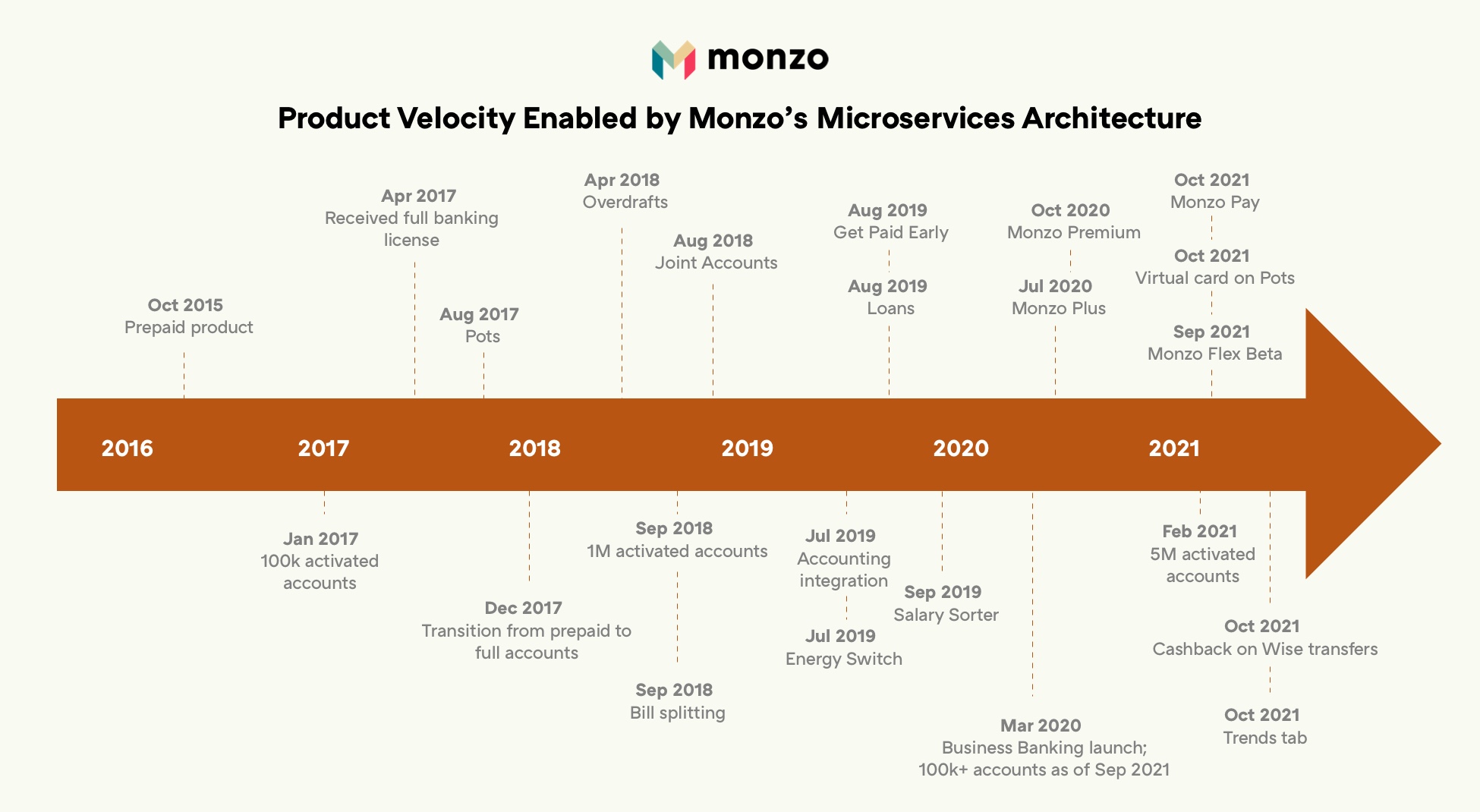
Building a community-centric product focused on transparency and authenticity
From the early days, Monzo chose to build the company alongside their customers. NPS scores suggested that UK consumers were, at best, apathetic about their bank. When Monzo launched its pilot product in October 2015, they invited their 500 alpha users to attend events hosted by the founding team, instead of just having them download the app. The purpose of these events was to establish a community of passionate adopters and communicate how different Monzo could be from traditional banks. Monzo even invited customers to invest in the company, offering special benefits and investor cards. Monzo also hosted community hackathons where early adopters could build on top of Monzo’s API. Some of these user-generated ideas made their way into the main product, like one that rounds up spare change. Monzo’s crowdfunding campaigns raised over £35 million (which was critical at the time as being a bank requires having upfront capital) and generated best-in-class engagement from the very beginning.
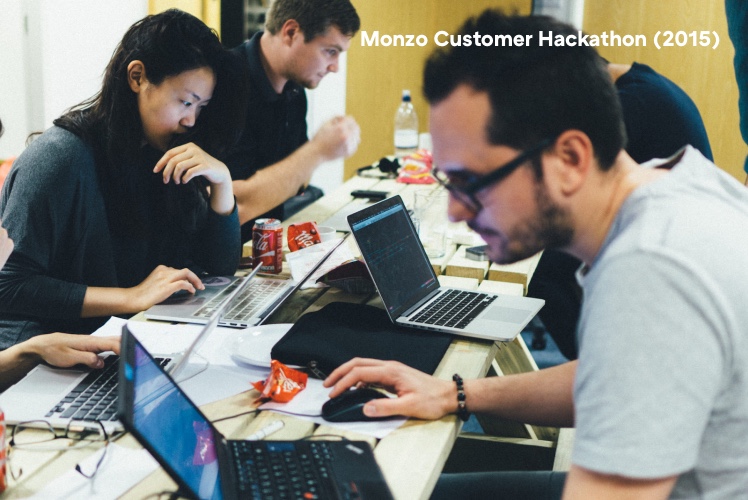
Monzo also believed a policy of total transparency would crucially define the company as community-oriented. From its very early days, Monzo defaulted to transparency regardless of how it portrayed the company. An early example was its approach to technical hiccups. Whenever there was an app or card outage, the company published deep dives on the problems and what they did to fix them.
As Monzo has scaled to become the leading neobank in the UK, it has continued to mindfully launch features with an emphasis on treating customers fairly and having a positive social impact. Our five favorite examples are outlined below:
(1) Gambling block: One of the features that best highlights Monzo’s commitment to better money management is Gambling Block, a feature where customers can disable transactions tagged as gambling. This feature might seem counterintuitive for banks traditionally incentivized to maximize monthly spend and revenue. But Monzo’s employees enthusiastically believed Gambling Block advanced the company’s customer-centric vision by encouraging better spending habits. The feature was actually devised by a small team of Monzonauts during “Monzo Time,” a monthly event during which employees can work on anything important to them. As of February 2021, Gambling Block was being used by 275,000 customers and was blocking nearly 600,000 transactions per month.
(2) Tone of voice guide: In 2017, Monzo published a Tone of Voice guide to maintain its clear, concise, positive voice as it scaled. This includes everything from Monzo’s terms and conditions, which have the required reading age of 11, to the way customer support agents communicate with customers.
(3) Proactive transparency: Like all banks, Monzo has visibility into customer spending. Unlike all banks, Monzo uses this visibility to go above and beyond in proactively supporting users. In 2018, Monzo’s financial crime and security team noticed a concentrated number of fraudulent Ticketmaster transactions and immediately updated its systems to block suspicious transactions, alerted relevant parties, and proactively replaced customers’ cards. Two months after receiving information from Monzo, Ticketmaster announced the breach that compromised card details.
(4) Fair-use fees and customer-friendly lending: In 2020, Monzo introduced fair-use fees for customers who used certain features above normal levels and created higher levels of free allowances for customers who used Monzo as their main account. The new fees impacted fewer than 30% of Monzo customers and were well-received by the community. Another example of Monzo’s customer-centric approach is Monzo Flex, which is a better way to pay later. Instead of just launching another BNPL product, Monzo asked customers what they liked and disliked about existing lending products. Customers told them they didn’t want to have to reapply every purchase, they wanted flexible payment terms, and they wanted ubiquitous acceptance. Monzo Flex solves these problems by checking for affordability and letting users spread the cost across any purchase with flexible payment terms.
(5) Internal inclusion goals: Monzo’s company operating system was also designed with transparency, fairness, and authenticity. The company publishes an annual report of its progress on diversity and is on track to reach a 0% gender pay gap. Women make up 40% of their executive team and board. This focus on building an inclusive company operating system is one of the many reasons why Monzo is consistently rated the number one UK startup on LinkedIn.
In 2019, Monzo was recognized by YouGov as not just the most-recommended bank but consumer brand, and in 2020 it was rated the number-one bank for service quality per the Competition and Markets Authority. Monzo’s efforts to build a customer centric brand and their focus on building a best-in-class consumer product helped the company scale from 500 to 500,000 users less than 24 months after initial Alpha launch and less than 6 months after launching full bank accounts.
Scaling Monzo: Growing to 5M+ users and 100K businesses in 5 years
Monzo’s second chapter has been even more impressive. Since launching in the UK five years ago, Monzo has scaled to 5.3 million users, or more than 10% of the adult population. In an incredibly short amount of time, Monzo has managed to turn a good product into a highly competitive platform with a significant market share. And they did it by spending only £20M on marketing in one year, or <£20 per customer. In the years since, they’ve spent £0 on marketing.
Scaling the customer base efficiently and effectively
Monzo used its early enthusiastic community to drive new customer growth. In designing its cards, Monzo chose an eye-catching hot coral color. The card became a conversation piece, as curious bystanders asked Monzo customers about it, which would naturally result in new signups. Monzo then built social features to supercharge word-of-mouth growth. It launched Golden Tickets that customers could give to their friends to skip the waitlist, peer-to-peer payments, and contact list sharing between friends. These social features accelerated user growth to 5% week-over-week and helped Monzo scale to over one million users with effectively zero marketing spend in a sector where customers typically cost £100–150 to acquire. Today, the average user has 30 friends on Monzo and 83% of active customers enable P2P payments within their first year. Like “Venmo me” in the US, “Monzo me” has become a fixture in the UK vernacular.
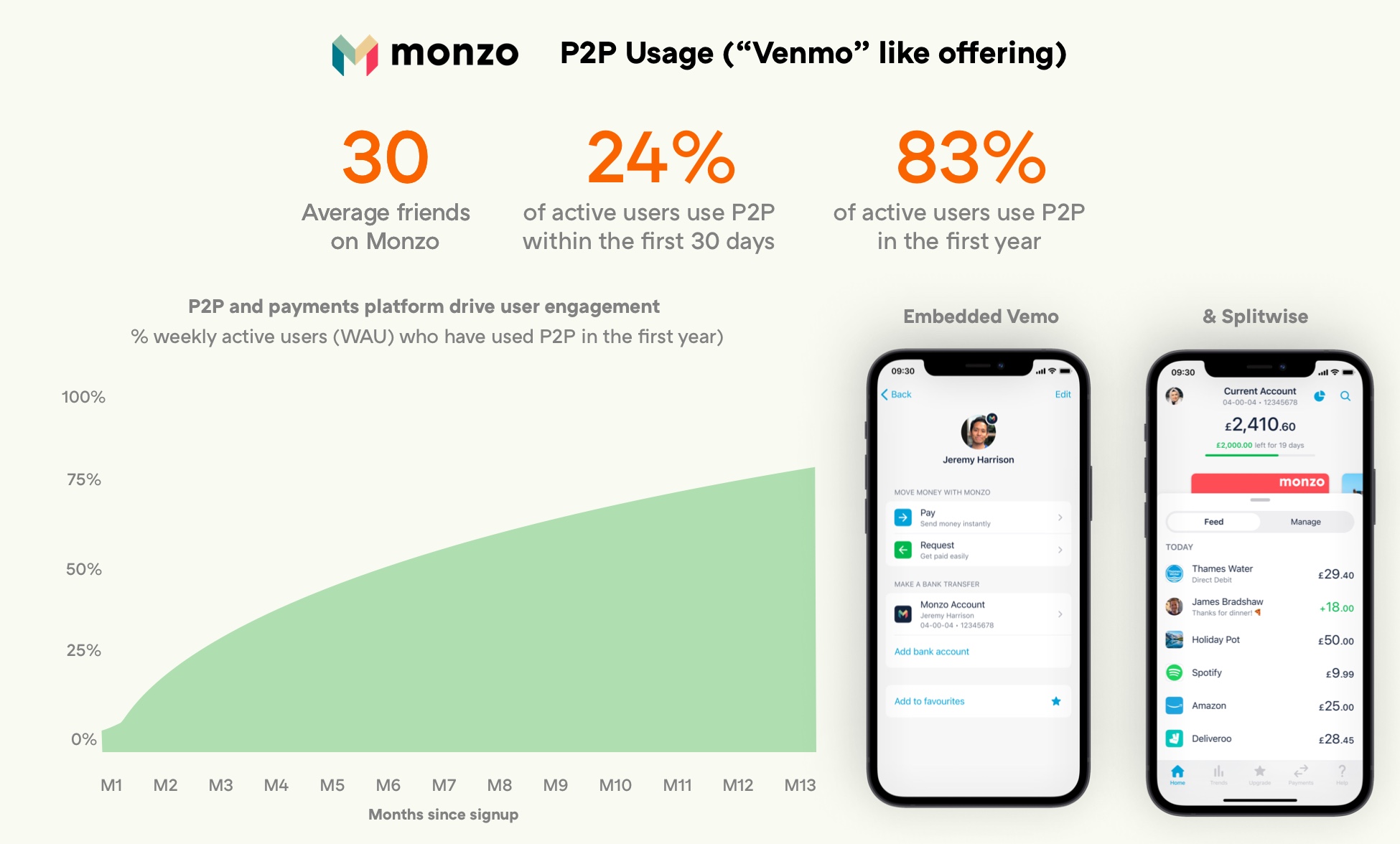
Monzo also expanded its product from a spending account to full-fledged bank account and financial control center. In its first few years, Monzo added basic banking features such as overdrafts, cash deposits, and direct debits to reach feature parity with traditional banking. In the past 18 months, Monzo revamped personal loans and launched premium subscription accounts with software features and perks such as third-party spend and savings tracking, virtual cards, custom categories, credit tracking, exclusive merchant discounts, and insurance. Today, Monzo isn’t just a complete bank replacement; it’s the best consumer banking experience in the world.
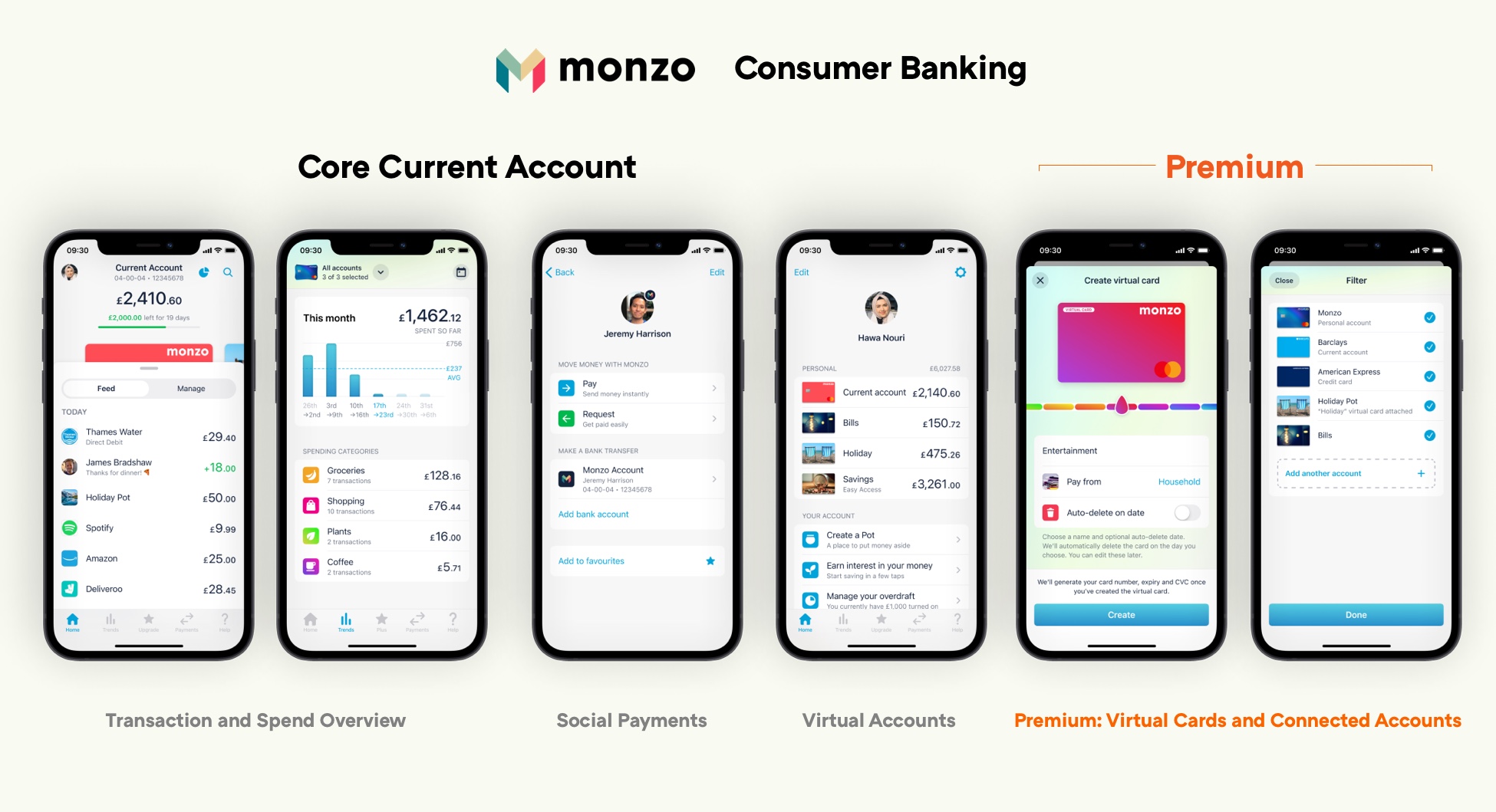
Monzo has successfully scaled its customer support and banking infrastructure alongside its user base. There is an entire product team dedicated to building software for customer support agents to surface customer information in seconds and maintain a consistent customer voice across every interaction. This is an enduring advantage over peers that rely on third-party software or automated support systems.
Monzo has also scaled its internal banking infrastructure. When it first launched, Monzo partnered with third-party payment processors to get to market quickly. Over time, Monzo migrated to internal systems and now has the lowest downtime in the entire banking industry (incumbents and startups). With these backend improvements, Monzo has been able to grow from a tiny startup to a major banking platform while maintaining a 70 NPS. In 2021, over 40% of active customers were using Monzo as their main account, up more than 10 percentage points from 2020.
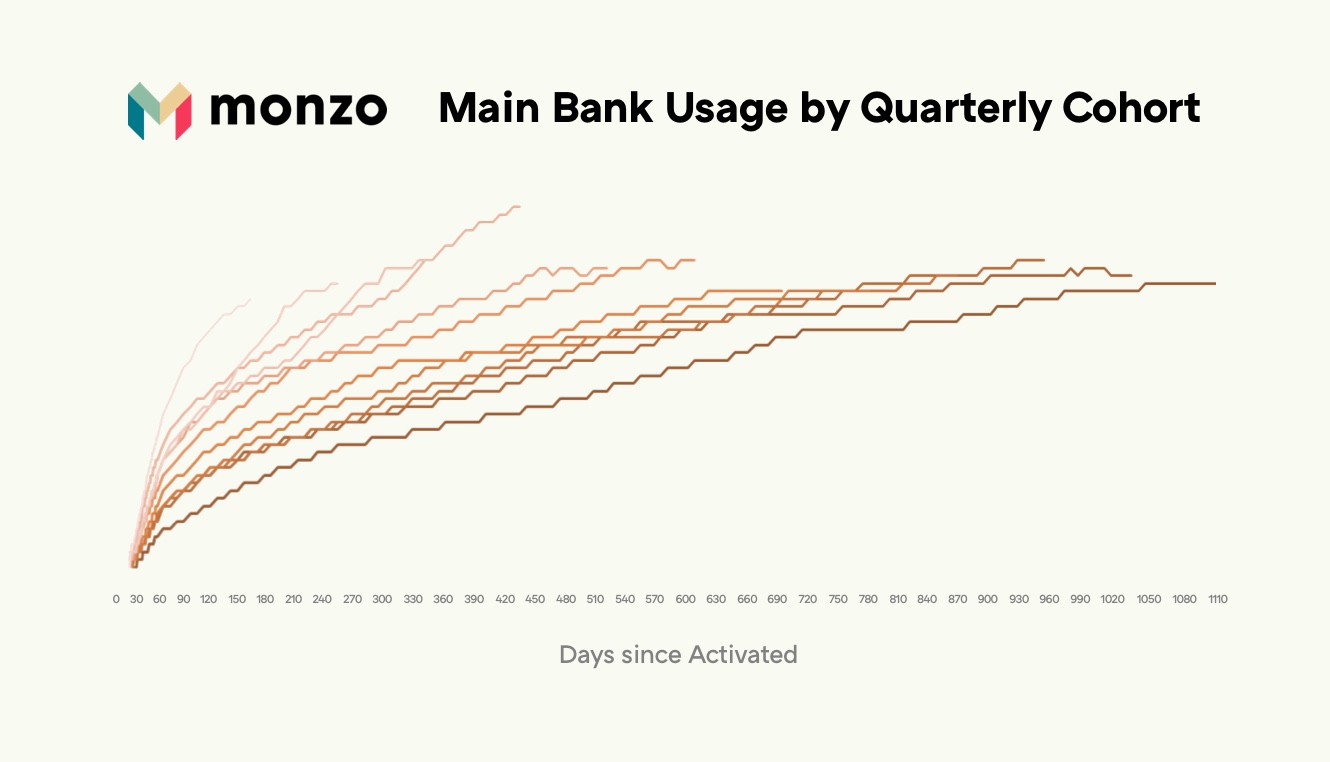
A natural transition to business banking
As Monzo’s consumer brand scaled, the team saw an opportunity to launch a banking product for small and medium businesses (SMBs) in the UK. The average business has 6x more deposits than the average consumer customer and Monzo already had more than 250,000 customers that owned a small business. Legacy banks were not meeting SMB needs, with the average business using 10 to 15 different financial products because SMB accounts were designed solely as transaction accounts. To solve this, Monzo launched business banking as a spending account with added software features such as invoicing, tax budgets, multi-user access, and accounting integrations. Since their SMB launch in April 2020, Monzo has organically scaled to over 100,000 businesses, outpacing every competitor. It took their closest competitor two years and significant marketing spend to reach the same scale.
Looking ahead, the company has an opportunity to serve larger businesses as well, by building financial operations tooling such as payables/receivables software and international payment capabilities. At scale, Monzo will be also uniquely positioned to enable seamless interactions between business customers and personal customers, similar to how Square does in the US.

Monzo’s opportunity: A leading consumer and business finance platform
The success of Monzo’s first five years will naturally lead to continued expansion within and outside of the UK. We think these are the most exciting opportunities for Monzo to disrupt the global banking landscape:
(1) Using great software to drive deep value for customers: Monzo is able to maintain customer-friendly fee structures and policies simply by cutting significant infrastructure operating costs. Their subscription banking product, which offers virtual cards, third-party account connections, and advanced budgeting features in exchange for a flat fee is fundamentally disruptive to incumbents. Today, Monzo’s long-term retention of premium customers outperforms incumbent financial services and is more inline with best-in-class consumer subscription companies like Calm, Netflix, and Spotify. Incumbents do not have the engineering talent or infrastructure to compete.
(2) Leveraging its two-sided network to build unique customer experiences: Because of its single-country focus, Monzo has been able to achieve deep reach among both consumer and SMB banking customers in the UK. The company now serves 10% of UK consumers, has 50%+ of UK neobank market share, and has 100,000 SMB customers. The company is in a unique position to build a consumer-to-business payment network in the UK, and has started to lay the foundation with products to help businesses get paid and Monzo Flex.
With Monzo’s business payments product, SMBs can collect payments via credit card and bank transfers, historically a huge pain point. Instead of sending invoices via email, businesses can send a Monzo payment link to customers. Early data shows high repeat usage, with the experience being meaningfully better when both the SMB and customer are Monzo users. As its two-sided network scales, more money will stay entirely within the Monzo ecosystem, resulting in better economics and experiences for both the company and its customers.
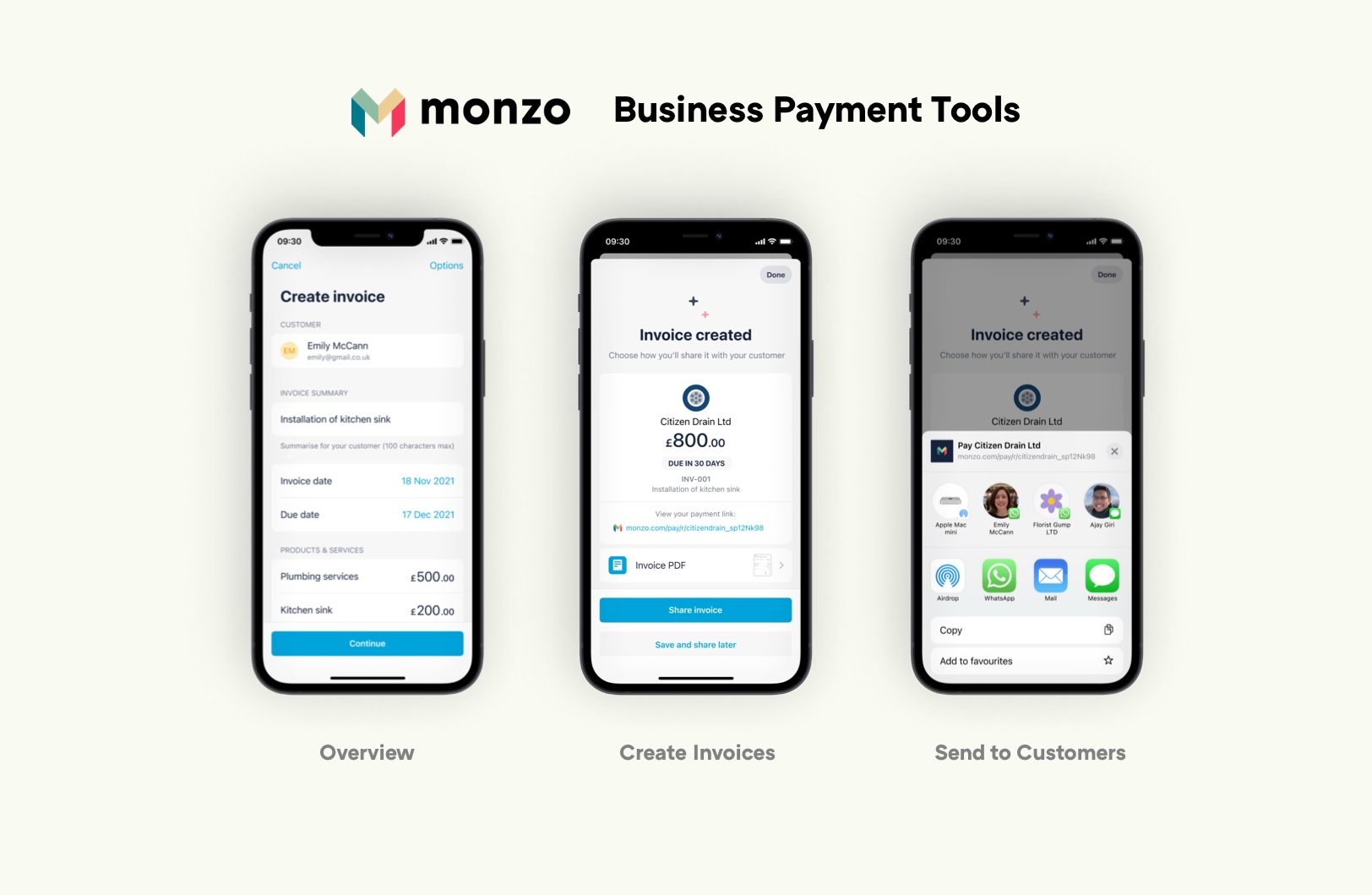
Monzo Flex is another product that benefits both consumers and businesses. Flex lets users finance purchases over £30 across multiple installments. Monzo’s natural visibility into users’ spending and financial health enables it to create a product that is better for consumers than traditional BNPL options. First, Monzo finances any transaction (offline or online) regardless of merchant partnership. Second, Monzo leverages its banking relationship to run affordability checks on users. This means Monzo will not approve Flex purchases for customers likely to end up in an endless cycle of debt. Traditional BNPL players can’t do this because it threatens their business model of prioritizing spend and merchant conversion. Over time, Monzo can even leverage its scale in the UK to sign partnerships with merchants to reduce costs for consumers. Flex could also disrupt the credit card market, as users use their virtual Flex cards instead of credit cards to finance payments. While early, the company has seen incredible demand for Flex only a few months after launch.
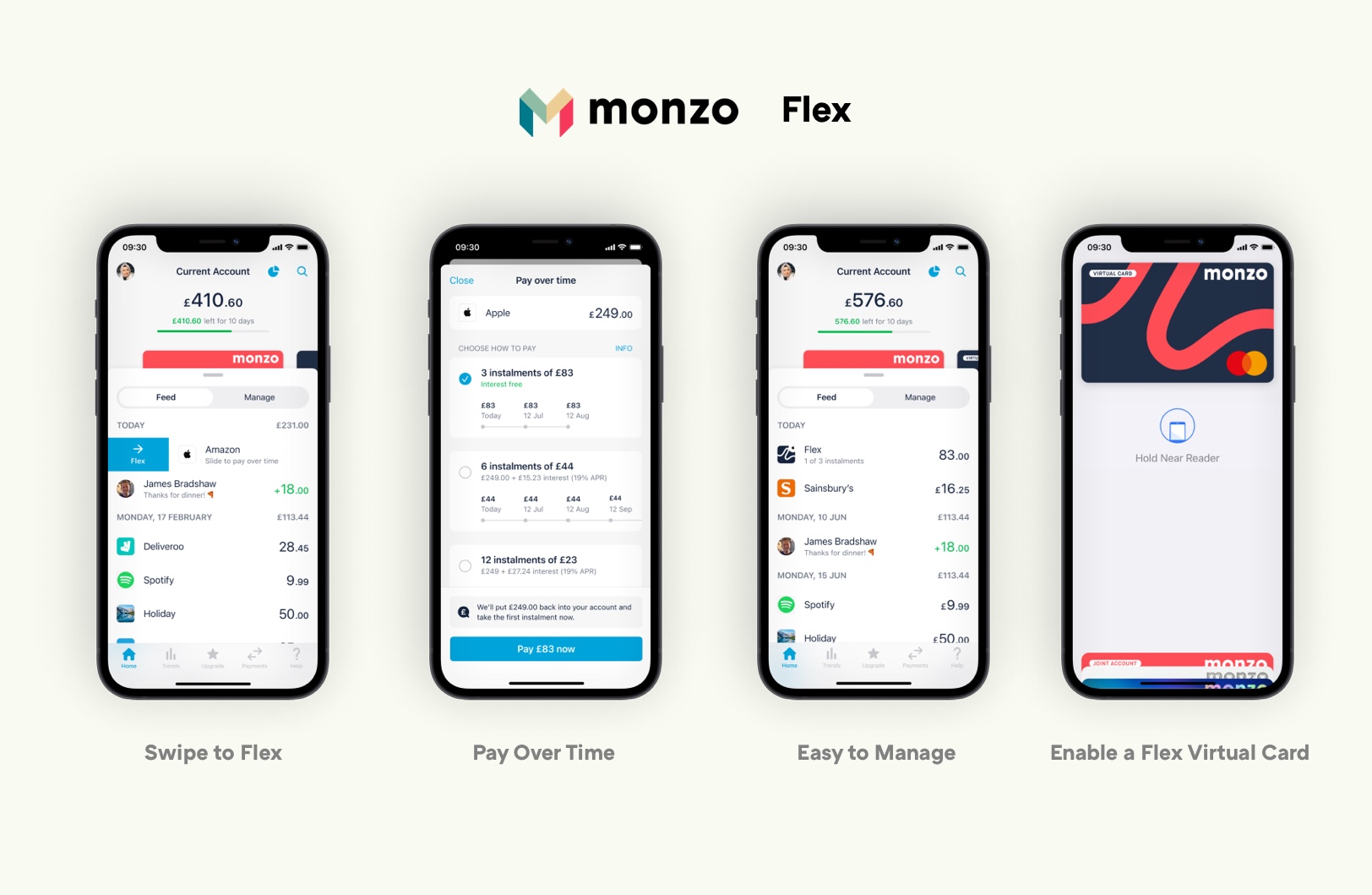
(3) Launching new financial tools: The UK banking market remains fairly disaggregated. A customer might use Monzo for banking, eToro for crypto, Freetrade for equities, and Atom for a mortgage. Monzo will continue to expand its offerings through both its own products and third-party partnerships (where Monzo acts as the front end or distribution engine). As one example, Monzo launched a savings marketplace for customers to earn additional returns two years ago. This product scaled to ~£1.5B in deposits and ~15% penetration of its customer base during a period of near-0% interest rates, creating value for both customers (by offering them higher returns) and deposit partners (who would otherwise have to pay large acquisition costs). Over time, Monzo will have increased opportunities to create new experiences for users in investing, crypto (e.g., staking, buying/selling), savings, and lending.
(4) Expanding internationally: The company has spent the last 12 months laying the foundation for its US launch. Rather than copy-pasting its home features to new geographies, Monzo is taking the same user-first design and community approach that won it the dominant position in the UK market. Monzo is running US-based community events, publishing a public product roadmap, and consistently adding new features. Monzo has already scaled the US product to 6,000 beta users and has 38,000 users on its waitlist. But unlike when it launched in the UK, Monzo now has five years of history and product work to leverage. This has enabled Monzo to launch features much faster in the US. Because of its strong foundation and country-specific product approach, Monzo is positioned to become a global financial platform and a major banking institution in every market it enters.
Conclusion: Spend, save, and manage your money in one place
Five years in, Monzo is just starting its second act. Monzo’s first act was to build the UK’s best consumer and SMB banking product. Their second act will be to make money work for truly everyone by scaling to a global audience. Over the next decade, the global market share of financial services will increasingly shift towards financial technology companies. We are already seeing signs of this shift within YC. Companies like Brex, Groww, Jeeves, Parker, and Point are capturing share from incumbents in their respective markets. Monzo will be one of the main beneficiaries of this shift, as it continues to compound its lead in the UK and drive growth in new markets.
Thank you to Max Winston, the entire Monzo team, Mia Mabanta, and Chloe Gordon for reading multiple drafts of this essay, and to Zain Ali for designing the graphics.
1 Financial Conduct Authority – Strategic Review of Retail Banking Business Models 
2 YC UK Survey on Consumer Banking – 2018 
3 Data from Monzo 
4 Public Filings and FCA’s Retail Banking Market Investigation 
Originally published on Y Combinator : Original article